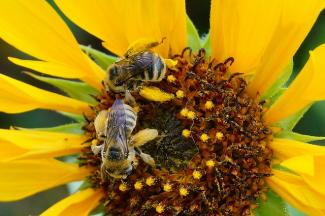
Image Credit: Debbie Ballentine
Digger (Burrowing) Bees (Anthophoridae: Anthophora, Habropoda)
These bees fly with the speed and grace of hummingbirds. They are large bees that tend to be most active early in the morning. One unique behavior, shared with the bumblebees, is the ability to “buzz-pollinate”. Buzz-pollination occurs when pendant flowers employ stamens with apical pores. To harvest pollen, the female bee must hang onto the flower upside-down and vibrate her whole body to remove the pollen through gravity, like using a salt-shaker. Anthophora urbana, one of the commonest summer bees in California, has been shown to be a very efficient pollinator of tomatoes.
The extremely similar Habropoda are restricted to the earliest springtime. They are especially important pollinators of many genera of the heath family (manzanita (Arctostaphylos), huckleberry (Vaccinium), salal (Gaultheria)). It is known that only a percentage of Habropoda will emerge from their nests in the spring, some waiting several years to finally emerge! Why would that strategy have evolved? It may be a strategy employed widely throughout the diversity of bees, but no one has ever investigated!

Like nearly all other members of the Anthophoridae family, the most conspicuous species of Anthophora and Habropoda are extremely robust. The dark, melanic species are found principally in the grasslands and chaparral in the earliest springtime (when it is very cool!).


Anthophora is an extremely abundant and universally distributed species, even in city gardens. It can be immediately recognized by its ability to fly like a hummingbird. It has a long tongue and is normally seen visiting tubular flowers, but it is an extreme generalist. If you are sitting in your garden in a non-threatening way, they will fly right up to your face and look you straight in the eye!